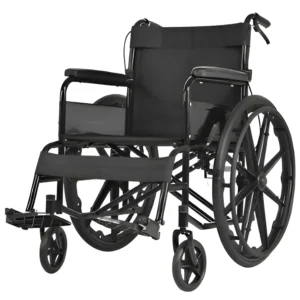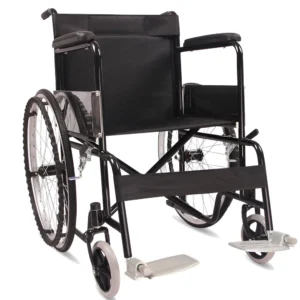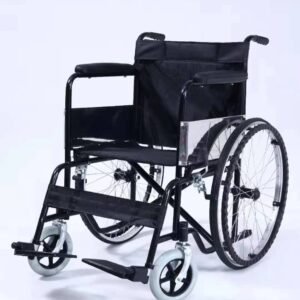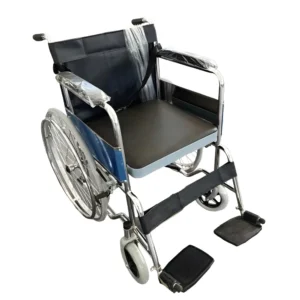Rigid Frame Wheelchair: A Complete Guide to Features, Benefits & FAQs
For individuals relying on wheelchairs for daily mobility, the choice between frame types can significantly impact comfort and functionality. Rigid frame wheelchairs, known for their sturdiness and performance, are a popular option for those prioritizing efficiency and durability. This guide answers all key questions about rigid frame wheelchairs, from what they are to how to choose, use, and maintain one.
What is a rigid frame wheelchair?
A rigid frame wheelchair is a mobility device with a fixed, non-folding frame, unlike the collapsible design of foldable wheelchairs. Its frame is a single, solid structure—typically made of lightweight materials like aluminum or titanium—crafted to provide stability and support. The rigid design eliminates the hinges and moving parts found in foldable models, creating a more streamlined, durable base. These wheelchairs are favored for their responsive handling, as the rigid frame transfers energy more efficiently when the user pushes the hand rims, making them easier to maneuver over long distances. They often have a sleek, low-profile look and are designed for active users who prioritize performance in daily life or even sports.
How does it differ from a foldable wheelchair?
The key differences stem from the rigid frame’s fixed structure:
- Portability vs. performance: Foldable wheelchairs are designed for easy transport—they collapse to fit in cars or storage spaces, making them ideal for travelers. Rigid frame models, being non-folding, are bulkier to transport but offer superior performance: the solid frame reduces energy loss when pushing, so users exert less effort to move, especially over uneven surfaces.
- Durability: Foldable wheelchairs have hinges and joints that can wear down with frequent folding/unfolding. Rigid frames, with no moving parts in the main structure, are more resistant to wear and tear, lasting longer with heavy use.
- Weight: Despite being non-folding, rigid frame wheelchairs are often lighter than foldable models. The absence of hinges and extra hardware (common in foldables) reduces overall weight, making them easier to push.
- Customization: Rigid frames are highly customizable—seats, backrests, and wheel positions can be adjusted to fit the user’s body perfectly, a feature critical for long-term comfort. Foldable models offer less customization due to their collapsible design constraints.
Who can benefit from using a rigid frame wheelchair?
- Active daily users: Individuals who use their wheelchair for long periods (e.g., commuting, work, errands) appreciate the efficient energy transfer, which reduces fatigue from pushing.
- Users prioritizing durability: Those needing a wheelchair for years of heavy use (e.g., permanent mobility limitations) benefit from the rigid frame’s resistance to wear.
- Sports enthusiasts: Adaptive athletes often choose rigid frame wheelchairs for sports like basketball or racing, as the stable frame enhances control and speed.
- Users with specific posture needs: The customizable design allows for tailored support (e.g., lumbar adjustments, seat angle tweaks) to address posture issues or prevent pressure sores.
What key features should you look for when choosing one?
- Frame material: Aluminum is the most common—lightweight (15–30 lbs) and durable. Titanium frames are lighter (10–20 lbs) and stronger but more expensive, ideal for active users.
- Wheel size and type: Larger rear wheels (24–26 inches) improve efficiency on long distances, while smaller wheels (20 inches) offer better maneuverability in tight spaces. Pneumatic (air-filled) tires provide a smoother ride; solid tires are low-maintenance but less shock-absorbent.
- Seat dimensions: Ensure the seat width (16–20 inches) and depth fit the user’s body to avoid pressure points. Look for padded, breathable upholstery (e.g., mesh) for comfort during extended use.
- Adjustability: Check if the backrest height, armrests, and footrests are adjustable. Customizable features let you tailor the chair to the user’s unique needs.
- Brakes: Reliable, easy-to-reach hand brakes are essential. Some models have “parking brakes” that lock securely on slopes.
How to use a rigid frame wheelchair safely?
- Maneuvering skills: Use the hand rims close to the wheels for better control—push forward firmly but smoothly to avoid sudden jolts. When turning, lean slightly into the turn to maintain balance.
- Transfer safety: Always lock the brakes before getting in or out. Use grab bars or a caregiver’s assistance to avoid tipping. The rigid frame’s stability makes transfers easier than with wobbly foldable models, but caution is still key.
- Loading for transport: Since rigid frames don’t fold, use a wheelchair lift or ramp to load into vehicles. Secure the chair with straps to prevent movement during transport.
- Terrain awareness: While rigid frames handle smooth surfaces well, avoid rough terrain (e.g., gravel) without pneumatic tires, as they absorb shocks less effectively than suspension-equipped models.
What maintenance is required?
- Frame care: Clean the frame weekly with a damp cloth to remove dirt and sweat, which can corrode metal. Inspect for scratches or dents—titanium and aluminum are rust-resistant, but deep damage may weaken the structure.
- Wheel and tire upkeep: Check tire pressure (for pneumatic tires) every few days—under-inflation makes pushing harder and wears tires faster. Tighten loose spokes monthly to prevent wheel wobble. Lubricate wheel axles quarterly to keep movement smooth.
- Brake checks: Test brakes weekly by locking them and trying to push the chair—if it moves, adjust the brake pads. Replace worn brake cables or pads promptly to avoid accidents.
- Upholstery maintenance: Clean seat and backrest fabric with mild soap to prevent stains. Repair small tears immediately; replace upholstery if it’s worn thin to maintain support.
Are there drawbacks to consider?
The main downside is limited portability. Rigid frame wheelchairs can’t fold, so they require more storage space and are harder to fit into small cars without a lift. They’re also less ideal for users who need frequent transport (e.g., frequent travelers) or have limited storage at home. For these cases, a foldable model may be better, despite its lower performance.
Thank you for reading this, dear, if you have any suggestions about our website or want to know about wheelchair, please contact us. We will respond quickly.



